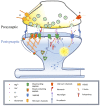Approaches and Limitations in the Investigation of Synaptic Transmission and Plasticity
- PMID: 31396073
- PMCID: PMC6667546
- DOI: 10.3389/fnsyn.2019.00020
Approaches and Limitations in the Investigation of Synaptic Transmission and Plasticity
Abstract
The numbers and strengths of synapses in the brain change throughout development, and even into adulthood, as synaptic inputs are added, eliminated, and refined in response to ongoing neural activity. A number of experimental techniques can assess these changes, including single-cell electrophysiological recording which offers measurements of synaptic inputs with high temporal resolution. Coupled with electrical stimulation, photoactivatable opsins, and caged compounds, to facilitate fine spatiotemporal control over release of neurotransmitters, electrophysiological recordings allow for precise dissection of presynaptic and postsynaptic mechanisms of action. Here, we discuss the strengths and pitfalls of various techniques commonly used to analyze synapses, including miniature excitatory/inhibitory (E/I) postsynaptic currents, evoked release, and optogenetic stimulation. Together, these techniques can provide multiple lines of convergent evidence to generate meaningful insight into the emergence of circuit connectivity and maturation. A full understanding of potential caveats and alternative explanations for findings is essential to avoid data misinterpretation.
Keywords: LTP (long term potentiation); analysis; electrophysiology; evoked potential; mEPSCs; spontaneous release; synapse.
Figures

Similar articles
-
Reduced presynaptic efficiency of excitatory synaptic transmission impairs LTP in the visual cortex of BDNF-heterozygous mice.Eur J Neurosci. 2006 Dec;24(12):3519-31. doi: 10.1111/j.1460-9568.2006.05242.x. Eur J Neurosci. 2006. PMID: 17229100
-
Structural and Functional Synaptic Plasticity Induced by Convergent Synapse Loss in the Drosophila Neuromuscular Circuit.J Neurosci. 2021 Feb 17;41(7):1401-1417. doi: 10.1523/JNEUROSCI.1492-20.2020. Epub 2021 Jan 5. J Neurosci. 2021. PMID: 33402422 Free PMC article.
-
Xenon modulates synaptic transmission to rat hippocampal CA3 neurons at both pre- and postsynaptic sites.J Physiol. 2019 Dec;597(24):5915-5933. doi: 10.1113/JP278762. Epub 2019 Nov 8. J Physiol. 2019. PMID: 31598974
-
LTD, LTP, and the sliding threshold for long-term synaptic plasticity.Hippocampus. 1996;6(1):35-42. doi: 10.1002/(SICI)1098-1063(1996)6:1<35::AID-HIPO7>3.0.CO;2-6. Hippocampus. 1996. PMID: 8878740 Review.
-
Presynaptic LTP and LTD of excitatory and inhibitory synapses.Cold Spring Harb Perspect Biol. 2012 Feb 1;4(2):a005728. doi: 10.1101/cshperspect.a005728. Cold Spring Harb Perspect Biol. 2012. PMID: 22147943 Free PMC article. Review.
Cited by
-
Live Imaging and Quantitative Analysis of Organelle Transport in Sensory Neurons of Aplysia Californica.Methods Mol Biol. 2022;2431:23-48. doi: 10.1007/978-1-0716-1990-2_2. Methods Mol Biol. 2022. PMID: 35412270
-
Distinct GABAergic modulation of timing-dependent LTP in CA1 pyramidal neurons along the longitudinal axis of the mouse hippocampus.iScience. 2024 Feb 22;27(3):109320. doi: 10.1016/j.isci.2024.109320. eCollection 2024 Mar 15. iScience. 2024. PMID: 38487018 Free PMC article.
-
Inferring monosynaptic connections from paired dendritic spine Ca2+imaging and large-scale recording of extracellular spiking.J Neural Eng. 2022 Aug 23;19(4):046044. doi: 10.1088/1741-2552/ac8765. J Neural Eng. 2022. PMID: 35931040 Free PMC article.
-
Sexually dimorphic characteristics of dopamine D1 receptor-expressing neurons within the shell of the nucleus accumbens of adolescent mice.Res Sq [Preprint]. 2023 Dec 16:rs.3.rs-3717874. doi: 10.21203/rs.3.rs-3717874/v1. Res Sq. 2023. Update in: Biol Sex Differ. 2024 Jul 13;15(1):54. doi: 10.1186/s13293-024-00631-1. PMID: 38168228 Free PMC article. Updated. Preprint.
-
A Practical Guide to Using CV Analysis for Determining the Locus of Synaptic Plasticity.Front Synaptic Neurosci. 2020 Mar 27;12:11. doi: 10.3389/fnsyn.2020.00011. eCollection 2020. Front Synaptic Neurosci. 2020. PMID: 32292337 Free PMC article.
References
LinkOut - more resources
Full Text Sources

